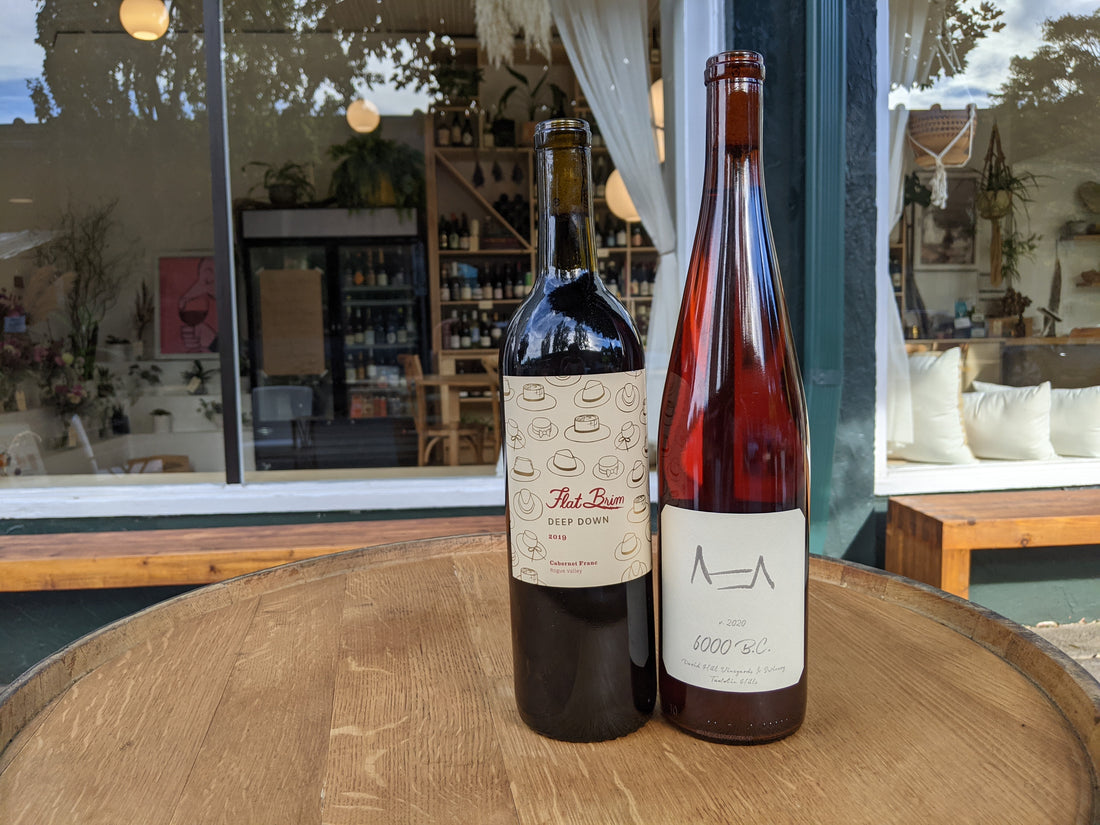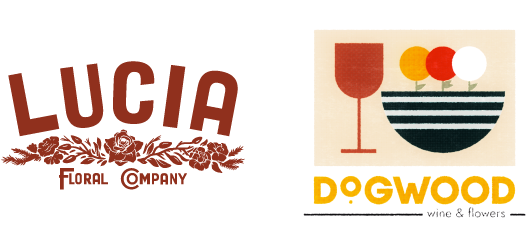
September 2021 - New/Alt Oregon
Wine Club - September 2021
The New Oregon
Aka ‘Not your papa’s Pinot’
Featuring:
David Hill Winery, ‘6000bc’ Tualatin Hills 2020 (Gewurztraminer, Pinot Gris, Riesling)
Flatbrim Wines, ‘Deep Down’ Cabernet Franc, Rogue Valley 2019
We can probably all agree that Oregon, or the Willamette Valley in particular, is a great place to grow Pinot Noir and Chardonnay. The climate is ideal, with cool nights and warm days for optimal retention of acid while ripening. The mix of volcanic, marine sedimentary, and glacial floodplain soils is perfect for varied styles. And the market for these grapes have exploded in the past 30 years. (Thank you, Paul Giamatti and Sideways.) In fact, Oregon is so good for Pinot and Chard, that people forget other things can grow here just as well. Or, at least it feels that way sometimes. Don’t be tricked, though, there is an exciting new wave of farmers and winemakers looking to break this 55-year tradition of excelling at these grapes.
But first, a tangent about rocks. It all began about 20 million years ago, when a string of volcanoes today known as the Blue Mountains sent volcanic basalt flows east into the valley. Yes, I know what you’re thinking. “They’re way in Eastern Oregon, plus there’s a huge mountain range in the way, how did the lava get here?” Well actually, Hood, Jefferson, Adams, etc are actually much younger Volcanoes and didn’t exist for another 19 mil years. Mind boggling.
So, after the valley floor is littered with lovely, well-draining volcanic rocks, and after the Cascade range is formed, we fast forward to the Missoula Floods. These took place roughly 15,000 years ago, when the earth was just finishing it’s last ice age period. During the ice age, the glacial ice cap covering Canada had progressed south to block the flow of the Clark Fork River (near Sandpoint, ID). Centuries later, when the glacier first started to recede, the ice dam caused the water to back up and form the massive glacial Lake Missoula across northwestern Montana. Eventually, the dam melted and an unfathomable amount of water flooded across Eastern Washington (Walla Walla Valley), through the Columbia Gorge, and into the Willamette Valley. This happened several more times over a ~5,000 year period and eventually left the valley with a rich and fertile deposit of topsoil.
We move another 12,000 or so years forward to the 1960’s and find pioneers such as Richard Sommer (Hillcrest Vineyard), David Lett (The Eyrie Vineyard), Charles Coury (David Hill), Dick and Nancy Ponzi, Susan Sokol-Blosser and Bill Blosser, Dick Erath and David Adelsheim paving the way for quality Oregon wine. This ‘first wave’ of Oregon wineries opened up the path for the second and third wave of Oregon winemakers (such as Beaux Freres, Argyle, Domaine Serene, and Domaine Drouhin) who are now considered classics in their own right. Today, we explore some even newer winemakers on the scene.
David Hill Winery, ‘6000bc’ Tualatin Hills 2020 (Gewurztraminer, Pinot Gris, Riesling)
David Hill, which was founded in 1965 as Charles Coury vineyards and based on a homestead from the 1880’s that also grew wine, seems like an odd fit for a month we focus on ‘New Oregon’. It’s arguably one of the most classic Oregon estates, after all. However, with the addition of energetic and enthusiastic winemaker Chad Stock, the brand is back in the contemporary spotlight. Chad, who makes wine for his label, Ltd+ (aka Limited Addition), which he founded with his wife Bree Stock MW, is passionate about organic farming, low-intervention winemaking, and constant experimentation in the cellar.
6000bc is part of a ‘discovery series’ launched by Chad within the David Hill label. Instead of focusing on the winery’s traditional bottlings of Pinot Noir, Chardonnay and Riesling, they utilize some of the oldest vines on the estate to make captivating and modern wines from other Alsatian whites - Gewurztraminer, Pinot Blanc, Sylvaner & More. (Charles Coury studied in Alsace in the 1960’s, When he was looking for a similar terroir to plant these grapes, he found the Northern Willamette to be the most ideal.)
This wine, in particular, is one of the furthest out on the edge. It comprises three grapes (60% Pinot Gris, 30% Gewurtz, and 10% Riesling) that are all macerated on their skins in open top vessels before being transferred to Amphora. These earthenware vessels, also called Qvevri, are traditionally used in ancient Georgia - the birthplace of wine. While many producers will only age the wine in these vessels, Chad chose to finish the last bit of fermentation in the Amphora, which allowed the wine to pull out a bit of the drying clay characteristic. As with most of our selections, there are only a few ingredients - LIVE certified grapes, yeast nutrient (for the native yeasts living on the grapes), and a touch of sulfur.
The result is a beautiful amber-hued ‘Orange Wine’ that has delicate, lifted aromas, a fine grained tannic structure, and an elegant finish. You can drink this at just below cellar temp (50-55 deg), like you would a nice Chardonnay. No need to chill it to frigid temperatures or some of the aromatics may be muted.
Pairing - Orange Wines pair well with too many things. From the cheesy/nutty dishes of Europe, to spicy fermented dishes of East Asia, to the fragrant dishes of West Asia / Africa.
Flatbrim Wines, ‘Deep Down’ Cabernet Franc, Rogue Valley 2019
Remember all that wonderful geological history about the Willamette Valley? Good! But it doesn’t apply here. The Rogue Valley, which is in the south of the state and encompasses the area along the I-5 corridor (Ashland, Medford, Grant’s Pass) with Eastern/Western boundaries roughly near Shady Cove and Cave Junction, has a vastly different geological and human history than the Willamette. For starters, the soil formations are about 2x as old, with alluvial floodplanes from the Eocene era (50+ mil years ago) being disrupted and broken up when the Klamath Mountains rose through the region about 20 million years ago. These now-eroded sedimentary rocks are the defining characteristic of the area and are visible as you drive the region in the form of bluffs, cliffs, and rolling sandstone hills.
The human/wine history of the area is also a bit older. The Willamette was two cold to comfortably grow grapes for the reason many settlers originally wanted - easily-fermentable table wine and/or high potential alcohol for Brady distillation. The Rogue with it’s warmer and drier climate, was perfectly suited to this. Oregon’s first winery, Valley View Vineyard, was opened in the Rogue in the mid-1800’s, and while the region has almost a two-hundred year grape growing history at this point, it wasn’t even given official appellation status until 2001.
Today, the Rogue Valley deserves a special place in the Oregon wine lexicon, as it is the perfect combination of dry heat and large diurnal swings to optimally ripen grapes like Cabernet Sauvignon, Syrah, Chenin Blanc, Merlot, Zinfandel, Cabernet Franc, and many more. Without the Rogue, Oregon’s wine scene would lack some serious diversity!
This label, Flatbrim Wines, is the brainchild of couple Ian and Becky Atkins. Their wines are made from throughout OR and WA and are usually cheekily named (‘Not Basic’ / ‘Not Cringey’) or homages to Ian’s home in the Lone Star State (‘Giant Sky’ / ‘Cicadas’). As a whole, their label focuses on higher acids, lower sugars, minimal intervention, and ultimate porch-pounder-ability. (All things that we value as well, as you may have learned). And the kicker, they make the wines in Portland (Selwood, to be exact), so you’re drinking local-esque! I could wax poetically about this wine, but better to hear it straight from the winemaker:
“Cabernet Franc has been the inspiration of our winery from the beginning. It was the first wine we ever made and continues to be a wine that we strive to improve upon and are excited every year when we receive the grapes. The Rogue Valley is also one of the best regions to produce Cabernet Franc in the world. A real Goldilocks zone, it’s warm enough to get the grapes ripe but cool enough to keep sugars low and allow the winemaker to choose the style.
Deep Down is intended to be a stand alone drinker. Meant to be shared, discussed and enjoyed. But, it will pair nicely with a meal and lend its character to any table”
Pairing: Grilled red meat, end of summer tomato salad, and a side of corn on the cob.
